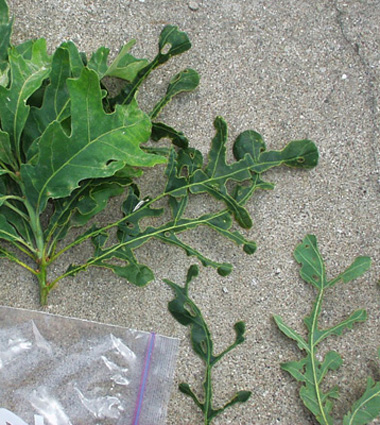Issue 8, June 12, 2009
Oak Tatters
Possibly you have seen this odd condition on your oaks. Sometimes the symptoms are very severe. Other times only one side of the tree is affected. Regardless, it usually causes some grower concern.
"Oak tatters" is a term coined for a condition that has occurred for at least 20 years in Illinois. The foliage appears to have been eaten by an insect, leaving only the major veins and a bit of tissue around the veins remaining intact. All soft tissues of the leaves are missing. The foliage is not scorched or necrotic. What remains of the leaf is usually green. In fact, the condition may go unnoticed because there is no brown tissue. The foliage appears lacey and green, and the canopy thinned. The image shows a typical case of oak tatters on white oak. Leaves on the left side of the image are normal. Leaves in the middle of the image, and those on the right, show "tatters" symptoms.

We have seen this problem in Illinois on white oaks or trees in the white oak group. Other oak species (not white oak group) located nearby are often unaffected.
"Oak tatters" has been reported in Illinois and other states as well, including Iowa, Indiana, Ohio, Michigan, Wisconsin, Minnesota, and Missouri. There are other problems that might resemble oak tatters. Anthracnose causes spring leaf damage but includes brown lesions on the foliage. Some insects will cause similar damage, so look for the insects (usually caterpillars) or evidence of insects, including frass or webbing.
No disease problem has been implicated. Likewise insects are not the cause. The suspects at this time are environmental stress and chemical injury. The affected trees eventually produce healthy new leaves. Recent work points strongly to herbicides as the cause of oak tatters.
In 2004, three researchers at the University of Illinois did a preliminary study that indicated that drift of chloroacetamide herbicides (possibly from applications onto corn and soybean fields) was a possible cause of the leaf tatters syndrome. The researchers were Dr. Jayesh Samtani, Dr. John Masiunas, and Dr. James Appleby. An article describing their work can be found in Plant Health Progress, an on-line journal. Look at February 2005. This work was repeated and once more reported in scientific literature. The second article appears in HortScience, December 2008. There has been some concern that a tree repeatedly affected by oak tatters might decline and even die. No evidence has been found to confirm this theory, but the question merits investigation. You may help your trees by following good horticultural practices to promote health, especially watering in periods of drought stress. For pictures of oak tatters, visit the US Forest Service pest alert on tatters. The herbicide research listed above was performed after this US Forest Service pest alert was produced.--Nancy Pataky
Author:
Nancy Pataky